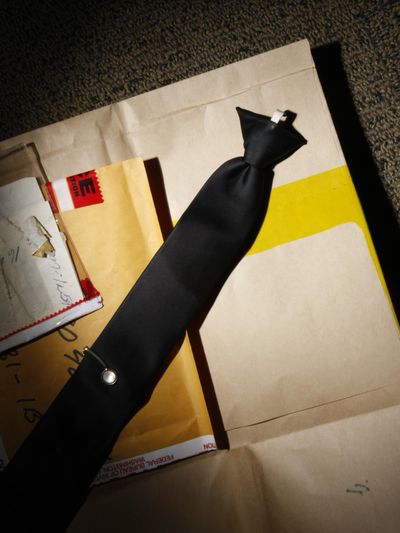Does D.B. Cooper evidence link hijacker to Boeing? Plot thickens

SEATTLE – You know the recent stories exploring whether D.B. Cooper was a Boeing employee?
Never mind. That theory only lasted a few days.
Time for a new speculation.
Now the attention of the “Citizen Sleuths” on whose research all those viral headlines were premised are pointing at another Pacific Northwest company as D.B.’s possible employer:
Tektronix, out of Beaverton, Ore.
Tek-what?
Not quite the name recognition as Boeing, but it’s well-known in the electronics industry.
The Boeing connection is still there, says Tom Kaye, of Sierra Vista, Arizona, who identifies himself as the principal investigator of CitizenSleuths.com.
It’s just that now the group believes the titanium particles found on D.B.’s tie came from Tektronix, which may have been doing contract work for Boeing back in the 1960s through 1971 (when the project was canceled) on the supersonic transport jet, better known as the SST.
The group was given access to the tie by the FBI and used a powerful electron microscope and X-ray spectroscopy for its work.
Kaye now believes that D.B. “was an engineer or manager type who was going back and forth between Boeing and Tektronix.”
Boeing understandably says that “we have no comment on these reports.” It’s trying to sell jets, not be associated with D.B. speculation.
As for Tektronix, it was founded in 1946 and holds 697 patents.
It makes things like oscilloscopes – which many of us have heard of even though we couldn’t explain what they do – and optical modulation analyzers. Let’s not even try to explain the latter.
Last week, Amy Higgins, spokeswoman for the company, said it didn’t have employment documentation in its database that would go back some five decades.
So it really couldn’t add much, she said. She also said if Tektronix had been doing work on the SST, it was likely “a confidential relationship.”
It’s been 45 years since “Dan Cooper” hijacked that Northwest Orient Airlines jet, and somewhere between Seattle and Reno parachuted out with $200,000 in $20 bills.
His legend is the gift that keeps on giving when it comes to stories we can’t help but read.
There was the woman who had undergone transgender surgery and claimed to have been D.B. as a way to get back at the airline industry that kept her from becoming a pilot.
There was the Minnesota man who believed his late brother was D.B. when the family discovered unaccounted-for money in the brother’s bank accounts. Plus, the brother had once said, “There is something you should know, but I cannot tell you.”
And there are plenty more potential D.B.s who have made the news but then not been linked to the case by the FBI.
The agency suspended active investigation in July 2016.
It’s that black clip-on J.C. Penney tie found on the seat cushion 18E, the same seat assigned to Cooper, that has been at the heart of these latest speculations.
D.B. had that now-retro look down pat. The kinda skinny tie, “alligator” tie clip, dark business suit, white shirt, aviator sunglasses.
It was the look you often would see with the engineers and management at Boeing. More dramatically, it was used by Quentin Tarantino in “Reservoir Dogs.”
D.B. ordered a bourbon and soda, smoked a cigarette and handed a flight attendant a note that said, in all capital letters, “I have a bomb in my briefcase. I will use it if necessary. I want you to sit next to me. You are being hijacked.”
When the attendant put the note, unread, into her pocket, D.B. said, “Miss, you’d better look at that note. I have a bomb.”
Dwight Bates, 74, of Ellensburg, a Boeing retired senior propulsion engineer who worked on the SST, remembers that clip-on-tie look well. He was 23 when he worked on that plane.
“Almost everybody wore a clip-on tie just like that,” he says. “Then, if you went up to the factory, you’d unclip it and put on your safety glasses. There was a lot of dirt out there and you didn’t want it on your tie, and you didn’t want your tie hanging up on rotating machinery.”
But maybe some tie-wearing type did keep his tie on at the factory floor, says Bates.
“There was a lot of titanium machining going,” he says. Particles would have flown about.
There is just one hitch with D.B. possibly being a Boeing employee.
The SST was being built with titanium alloy because supersonic “skin friction” would heat its hull to many hundreds of degrees Fahrenheit.
But the particles found on the tie were not titanium alloy. They were pure titanium.
Plus, additional testing showed the presence of rare earth elements such as cerium and strontium sulfide.
So.
So a little more speculation by the Citizen Sleuths:
- The rare earth particles found on the tie are used in the manufacture of cathode ray tubes, the kind used in old TV sets.
- Kaye says the SST was going to be the first plane using cathode ray tubes on the instrument panel.
- Tektronix at that time made such tubes and was a relatively short distance from Boeing.
- But for use in the SST, the Oregon company would have had to encase the tubes in titanium, and likely used pure titanium.
Connect the dots.